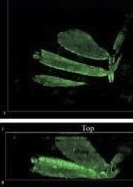by
Lauren Dubinsky, Senior Reporter | December 28, 2017

May help researchers better
understand the brain
A research team has developed a new lensless camera that can generate 3-D images without scanning.
For its first application, the DiffuserCam was used to examine microscopic neuron activity in living mice without a microscope.
"Our imaging approach could enable monitoring the activity of an extremely large volume of neurons in a freely moving animal," said Laura Waller, leader of the Computational Imaging Lab at the University of California, Berkeley. "Perhaps a smaller version of our device could eventually be used to enable a blind person to see."



Ad Statistics
Times Displayed: 78539
Times Visited: 2794 Ampronix, a Top Master Distributor for Sony Medical, provides Sales, Service & Exchanges for Sony Surgical Displays, Printers, & More. Rely on Us for Expert Support Tailored to Your Needs. Email info@ampronix.com or Call 949-273-8000 for Premier Pricing.
The camera is compact and inexpensive since it consists only of a diffuser placed on top of an image sensor. On the other hand, the software involved in reconstructing the high-resolution 3-D images is complex.
The DiffuserCam is within the light field camera family, which is technology that captures how much light is striking a pixel on a image sensor and the angle that it hits the pixel. These cameras have historically been expensive and limited in spatial resolution.
Waller sought to investigate whether better algorithms could replace the the expensive microlens arrays with a plastic surface with random bumps.
After Waller and her team developed the complex algorithms and experimented with various types of diffusers, they found that the simple light field camera concept was possible. The random bumps in the plastic actually improved on the conventional light field camera capabilities by using compressed sensing to avoid the loss of resolution.
They plan to use the DiffuserCam as part of the federal government's BRAIN initiative to develop implantable, biocompatible, neural interfaces that could help with visual or hearing impairments.
Initially, the team wants to create something called a cortical modem that can "read" and "write" the brains of animal models. The camera will be the core of the reading device.
Using that to view neurons fire in a mouse brain could help the team understand more about sensory perception, and potentially be used to cure diseases like Alzheimer's and mental disorders, according to Waller.
New imaging techniques are capable of capturing these neurons, but the DiffuserCam can image millions of neurons in one shot. The team hopes this will provide them with a better understanding of how the brain works on larger scales.
"The most compelling medical application is for
in vivo imaging of 3d dynamics of neurons in a freely moving animal," said Waller. "If neuroscientists want to correlate an animal's behavior with its neural activity, the animal needs to be able to move about its environment in a natural way."
Back to HCB News

